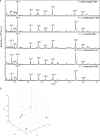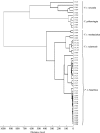Identification of Francisella tularensis by whole-cell matrix-assisted laser desorption ionization-time of flight mass spectrometry: fast, reliable, robust, and cost-effective differentiation on species and subspecies levels
- PMID: 20181907
- PMCID: PMC2849607
- DOI: 10.1128/JCM.01953-09
Identification of Francisella tularensis by whole-cell matrix-assisted laser desorption ionization-time of flight mass spectrometry: fast, reliable, robust, and cost-effective differentiation on species and subspecies levels
Abstract
Francisella tularensis, the causative agent of tularemia, is a potential agent of bioterrorism. The phenotypic discrimination of closely related, but differently virulent, Francisella tularensis subspecies with phenotyping methods is difficult and time-consuming, often producing ambiguous results. As a fast and simple alternative, matrix-assisted laser desorption ionization-time of flight mass spectrometry (MALDI-TOF MS) was applied to 50 different strains of the genus Francisella to assess its ability to identify and discriminate between strains according to their designated species and subspecies. Reference spectra from five representative strains of Francisella philomiragia, Francisella tularensis subsp. tularensis, Francisella tularensis subsp. holarctica, Francisella tularensis subsp. mediasiatica, and Francisella tularensis subsp. novicida were established and evaluated for their capability to correctly identify Francisella species and subspecies by matching a collection of spectra from 45 blind-coded Francisella strains against a database containing the five reference spectra and 3,287 spectra from other microorganisms. As a reference method for identification of strains from the genus Francisella, 23S rRNA gene sequencing was used. All strains were correctly identified, with both methods showing perfect agreement at the species level as well as at the subspecies level. The identification of Francisella strains by MALDI-TOF MS and subsequent database matching was reproducible using biological replicates, different culture media, different cultivation times, different serial in vitro passages of the same strain, different preparation protocols, and different mass spectrometers.
Figures



Similar articles
-
Proteogenomic biomarkers for identification of Francisella species and subspecies by matrix-assisted laser desorption ionization-time-of-flight mass spectrometry.Anal Chem. 2014 Oct 7;86(19):9394-8. doi: 10.1021/ac501840g. Epub 2014 Sep 23. Anal Chem. 2014. PMID: 25215633
-
The use of Matrix-assisted laser desorption ionization-time of flight mass spectrometry in the identification of Francisella tularensis.Bosn J Basic Med Sci. 2016 Jan 15;16(2):132-8. doi: 10.17305/bjbms.2016.894. Bosn J Basic Med Sci. 2016. PMID: 26773181 Free PMC article.
-
Optimized application of surface-enhanced laser desorption/ionization time-of-flight MS to differentiate Francisella tularensis at the level of subspecies and individual strains.FEMS Immunol Med Microbiol. 2007 Apr;49(3):364-73. doi: 10.1111/j.1574-695X.2007.00216.x. FEMS Immunol Med Microbiol. 2007. PMID: 17378900
-
[Maldi-tof ms analysis for yersinia pestis, vibrio cholera, and francisella tularensis identification].Mol Gen Mikrobiol Virusol. 2015;33(2):3-8. Mol Gen Mikrobiol Virusol. 2015. PMID: 26182660 Review. Russian.
-
Genotyping of Francisella tularensis, the causative agent of tularemia.J AOAC Int. 2010 Nov-Dec;93(6):1930-43. J AOAC Int. 2010. PMID: 21313823 Review.
Cited by
-
Genome sequence of Francisella tularensis subspecies holarctica strain FSC200, isolated from a child with tularemia.J Bacteriol. 2012 Dec;194(24):6965-6. doi: 10.1128/JB.01040-12. J Bacteriol. 2012. PMID: 23209222 Free PMC article.
-
Accidental exposure to Burkholderia pseudomallei in the laboratory in the era of matrix-assisted laser desorption ionization-time of flight mass spectrometry.J Clin Microbiol. 2014 Sep;52(9):3490-1. doi: 10.1128/JCM.01238-14. Epub 2014 Jun 11. J Clin Microbiol. 2014. PMID: 24920780 Free PMC article. No abstract available.
-
Francisella tularensis Subspecies holarctica and Tularemia in Germany.Microorganisms. 2020 Sep 22;8(9):1448. doi: 10.3390/microorganisms8091448. Microorganisms. 2020. PMID: 32971773 Free PMC article. Review.
-
Analysis of synovial fluid in knee joint of osteoarthritis:5 proteome patterns of joint inflammation based on matrix-assisted laser desorption/ionization time-of-flight mass spectrometry.Int Orthop. 2012 Jan;36(1):57-64. doi: 10.1007/s00264-011-1258-y. Epub 2011 Apr 21. Int Orthop. 2012. PMID: 21509578 Free PMC article.
-
Rapid identification of Cryptococcus neoformans and Cryptococcus gattii by matrix-assisted laser desorption ionization-time of flight mass spectrometry.J Clin Microbiol. 2011 Aug;49(8):3050-3. doi: 10.1128/JCM.00651-11. Epub 2011 Jun 8. J Clin Microbiol. 2011. PMID: 21653762 Free PMC article.
References
-
- Arnold, R. J., and J. P. Reilly. 1998. Fingerprint matching of E. coli strains with matrix-assisted laser desorption/ionization time-of-flight mass spectrometry of whole cells using a modified correlation approach. Rapid Commun. Mass Spectrom. 12:630-636. - PubMed
-
- Broekhuijsen, M., P. Larsson, A. Johansson, M. Byström, U. Eriksson, E. Larsson, R. G. Prior, A. Sjöstedt, R. W. Titball, and M. Forsman. 2003. Genome-wide DNA microarray analysis of Francisella tularensis strains demonstrates extensive genetic conservation within the species but identifies regions that are unique to the highly virulent F. tularensis subsp. tularensis. J. Clin. Microbiol. 41:2924-2931. - PMC - PubMed
Publication types
MeSH terms
Substances
LinkOut - more resources
Full Text Sources
Other Literature Sources
Molecular Biology Databases
Research Materials

